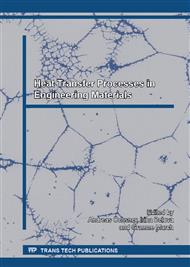p.97
p.103
p.111
p.121
p.129
p.135
p.147
p.159
p.169
Determination of Thermal Diffusivity and Influence of Defect Structure in Alloys Based on the Fe-Al System
Abstract:
Alloys of the Fe-Al system are interesting due to occurrence of long-range order and many thermal vacancies at high temperature, which lead to not only significant hardening, but also cause changes of physical properties. High temperature diffusion is conditioned by structural defects in solids, such as vacancies, foreign atoms and dislocations influencing thermal characteristics of a solid solution, among others the thermal diffusivity coefficient. Measurement of thermal diffusivity was performed at room temperature using the laser flash method. For characterization of the defect structure, positron annihilation lifetime spectroscopy was used. The data were presented for alloys with 28 and 38 at.% aluminium without chromium and containing 5 at. % Cr addition. The results showed that thermal diffusivity decreased with aluminium content and deviation from stoichiometry. In the studies, different structural defects in the alloys were observed.
Info:
Periodical:
Pages:
129-134
Citation:
Online since:
March 2013
Authors:
Keywords:
Price:
Сopyright:
© 2013 Trans Tech Publications Ltd. All Rights Reserved
Share:
Citation:


